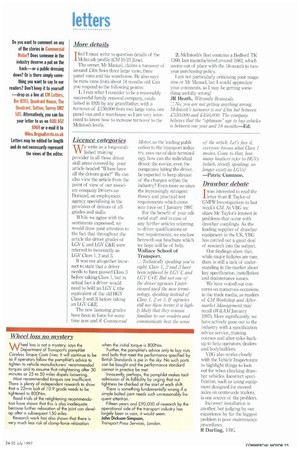Licence categories
Page 25

If you've noticed an error in this article please click here to report it so we can fix it.
We write as a long-established training provider in all those driver skill areas covered by your article headed "Where have all the drivers gone?" We can also view the article from the point of view of our associate company Drivers on Demand, an employment agency specialising in the provision of drivers of all grades and skills.
While we agree with the sentiments expressed, we would draw your attention to the fact that throughout the article the driver grades of LGV C and LGV C&E were referred to incorrectly as LGV Class 1, 2 and 3.
It was not altogether incorrect to state that a driver needs to have passed Class 3 before taking Class 1, but in actual fact a driver would need to hold an LGV C (the equivalent of the old HGV Class 2 and 3) before taking an LGV C&E.
The new licensing grades have been in force for some time now and if Commercial Motor, as the leading publication to the transport industry, uses out-of-date terminology, how can the individual driver, the novice, even the companies hiring the driver, be expected to keep abreast of the changes within the industry? Even more so since the increasingly stringent theory and practical test requirements which came into force on 1 January 1997.
For the benefit of your editorial staff and in case of any further articles referring to driver qualifications or test requirements, we enclose herewith our brochure which we hope will be of help. Wallace School of Transport.
Li Technically speaking you're right. Class 1, 2 and 3 have been replaced by LGV C and WV C+E. Rut not one of the driver agencies I interviewed used the new terminology, speaking instead of Class 1, 2 or a If agencies still use these terms it is highly likely that they remain familiar to our readers and communicate best 11w sense of the article. Let's face it, everyone knows what Class 1 means. Come to that, how many hauliers refer to HG Vs (which, strictly speaking, no longer exist) as LGVs? —Patric Cunnane.
T was interested to read the _Letter from R Taylor of GMPR Investigations in last week's CM. Al VBG we share Mr Taylor's interest in problems that occur with drawbar couplings. As the leading supplier of drawbar equipment in the UK, VBG has carried out a great deal of research into the subject.
Our findings show that, while major failures are rare, there is still a lack of understanding in the market about key specification, installation and maintenance issues.
We have voiced our concerns on numerous occasions in the trade media, as readers of CM Workshop and Aftermarket Management may recall (IMAM January 1997). More significantly, we have actively gone out to the industry with a specification advice service, training courses and after-sales backup to help operators, dealers and bodybuilders.
VBG also works closely with the Vehicle Inspectorate to highlight things to look out for when checking drawbar vehicles. Incorrect specification, such as using equipment designed for steered axles on centre-axle trailers, is one source of the problem.
Incorrect installation is another, but judging by our experience by far the biggest problem is poor maintenance procedures.
R Darling, VRG.








































































































